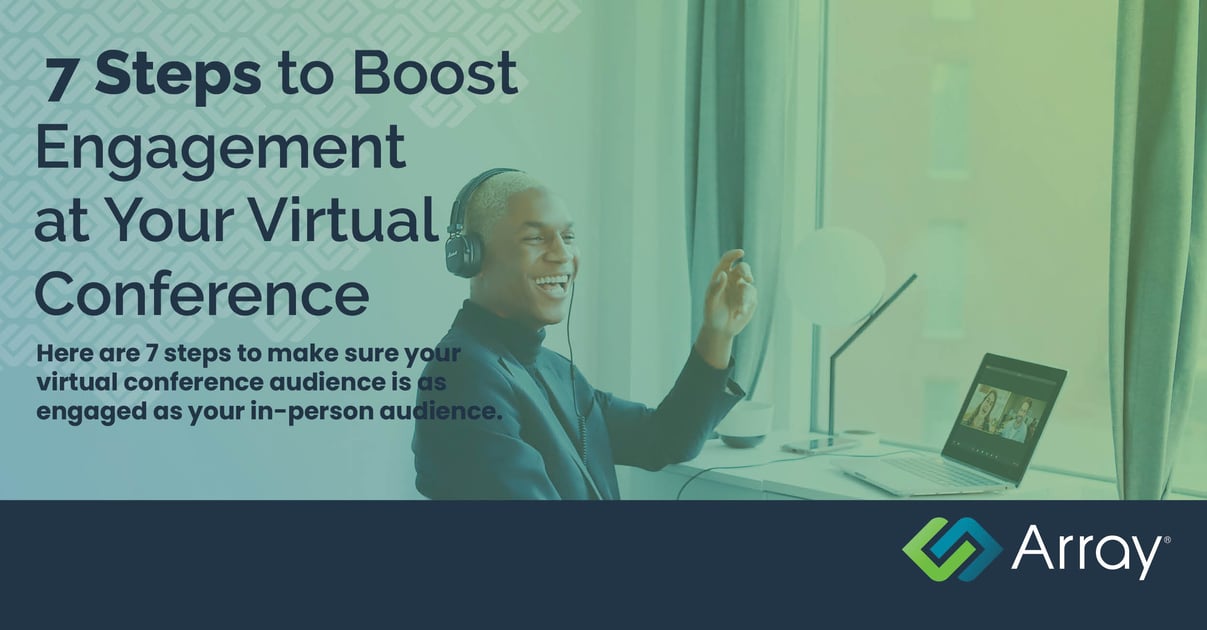7 Steps to Boost Engagement at Your Virtual Conference
May 13, 2021 •Array Team

Life sciences event planners and conference planners have made the difficult transition to virtual during the COVID-19 pandemic. Just as the industry was starting to test virtual and hybrid events, most in-person events were canceled and planners were forced to come up with new ways to bring audiences together.
Across all industries, not just life sciences, we saw an almost overnight scramble to replace live conferences with virtual ones.
Challenges like accommodating travel schedules and catering have been replaced by one key challenge: audience engagement. Leveraging technology to keep audiences engaged has transitioned from a “nice to have” to “must-have” to hold successful conferences online.
With that in mind, here are 7 recommendations to make sure your virtual conference audience is as engaged as your in-person audience.
1. Plan Engaging Sessions & Topics for Your Virtual Conference
Content and subject matter: The first step to audience engagement is making sure your topics and subject matter are relevant and of interest to your audience. Plan your sessions and breakouts so they are aligned to meet the learning objectives and needs of your potential attendees.
Presentation length: Most people can pay attention to a presentation for about 20 minutes. Sessions are rarely that short, so make sure your plan includes a lot of audience interaction.
2. Prepare a Roster of Engaging Virtual Presenters
Presenter experience: We have all experienced a novice virtual presenter. As you’re building your roster of speakers for your virtual conference, make sure they have experience with presenting virtually.
Presenter best practices: Provide speaker packets or videos with best practices to help your speakers prepare—tips for audio quality, lighting, sound, camera, background layout, and anything presenters need to make them look and feel professional while presenting.
Time for training and practice: Prior to your event, meet with presenters to ensure their equipment is working and they are fully trained on how to use all aspects of the technology you’re using for the conference. Provide technology training (through a scheduled meeting or recorded video or both) for all presenters.
Array’s Client Services provides this level of support. Learn more here.
3. Select the Right Types of Engagement for Your Audience
Polls, Q&A and gamification: Asking the audience to interact with the presenter at minimum every 20 minutes will help keep them focused on your screen or your presenter. Using the same platform to manage remote and in-person audiences will make it easier to engage everyone by running polls, encouraging questions for Q&A sessions throughout the presentation, and gamifying your content.
Breakout sessions for networking: Build in time for fun and social interaction. In-person conferences are special because you can organically network and bump into people. Virtual conference organizers are finding creative ways to encourage networking during virtual events.
4. Reduce Audience Distractions
Keep audiences focused on your presentation: Empower your audience to take notes and save the slides they find important, without leaving the screen. Let them move backward to review recent slides in case they want to quickly review something that was just presented. And keep the presentation deck in the same window as the presenter. The same goes for polls and Q&A: Don’t ask your audience to open a new window or switch to a different device to engage with you! You can do all of this with Array. See a full list of Array’s 25+ engagement features.
5. Choose Technology Solutions that Offer Support
Delegate stressful tech support: Technology failures will distract your attendees and lower engagement. As an event planner in life sciences, you want to make sure everything is perfect. Imagine delegating tech support to individual sessions to a capable team and relieving yourself of stressful tech support duties. Your attendees and presenters will appreciate a smooth experience and know exactly how to get tech support if they have questions. Be sure the technology solutions and platforms you choose for your event include best-in-class live tech support.
6. Use Data to Improve Engagement at Your Next Virtual Conference
Discover fresh insights: Study the data you collect during your virtual event and analyze the results of the presentations. For example: Were polls answered correctly? If not, perhaps new material wasn’t successfully delivered. What can the Q&A tell you about what your audience wants to learn? What can you learn from when engagement picked up or dropped off? Use the data you collect during a virtual event to make the next one even better.
Provide engagement reports that go beyond login/logout times: Your clients, presenters, or stakeholders may appreciate granular engagement reports that go beyond attendance numbers or login/logout times. Consider providing reports for individualized engagement data per participant, questions asked and answered, % correct, engagement with presenter, pre- and post-evaluations. These types of data are easy to capture using Array’s Content Engagement Software.
7. Virtual Conferences and Events Are Here to Stay
Virtual conferences and hybrid conferences will be with us for the foreseeable future. Make sure you can connect your experts with audiences in any location in a meaningful, measurable way. Array has helped life sciences companies and event planners improve engagement at their life sciences events for more than 15 years—at over 7,000 meetings with 1.5 million attendees.
Ready to improve engagement at your next life sciences event? Talk with an expert and see a software demo to understand how we can help you create a successful, smooth, and meaningful event—no matter where your audience is.
Did this article give you ideas for your next event? You’ll find more in-depth information and best practices in our free whitepaper: The Essential Guide to Planning Virtual and Hybrid Events.


